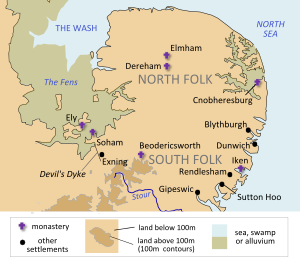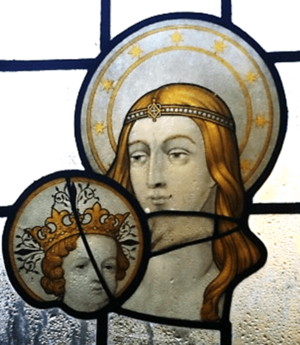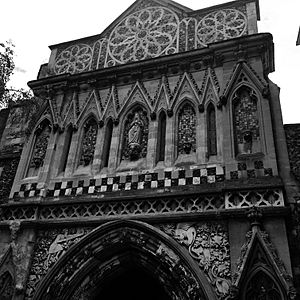Æthelberht II of East Anglia facts for kids
Quick facts for kids Saint Ethelbert of East Anglia |
|
|---|---|
| Born | c. 774 AD |
| Died | 794 AD Hereford |
| Venerated in | Catholic Church, Eastern Orthodox Church |
| Major shrine | Hereford Cathedral, England |
| Feast | 20 May |
| Attributes | A young king, sometimes bearded, holding a church and a palm branch |
| Patronage | Hereford, England |
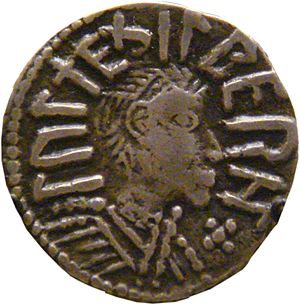
Æthelberht, also known as Saint Ethelbert the King, was a ruler of East Anglia. This was an Anglo-Saxon kingdom in what is now Norfolk and Suffolk, England. He died on May 20, 794, at Sutton Walls in Herefordshire.
Not much is known about his time as king, which might have started around 779. He was killed in 794 by order of Offa of Mercia, a powerful king from a nearby kingdom. After his death, Æthelberht was made a saint. People began to honor him in East Anglia and at Hereford, where his shrine once stood. His feast day is May 20. Many churches in England are named after him, and he is a special patron of Hereford Cathedral.
Contents
The Life of King Æthelberht

We don't know much about Æthelberht's life or his time as king. This is because very few records from East Anglia have survived from that period. Some later stories say his rule began in 779.
Mediaeval writers tried to fill in the missing details about his life. One writer, Richard of Cirencester, said Æthelberht's parents were King Æthelred I of East Anglia and Queen Leofrana. Richard wrote that Æthelberht was a very religious and wise king. He was encouraged to marry Eadburh, the daughter of King Offa of Mercia. Despite bad feelings from his mother and strange events like an earthquake, he went to visit Eadburh.
Coins of Æthelberht
Only four coins made by Æthelberht are known today. These coins are very important because they are some of the few things from his time that still exist. One coin found near Rome shows the word REX (Latin for King). It also has an image of Romulus and Remus being fed by a wolf. This image was a symbol of Rome.
The coins also name his moneyer, Lul, who also made coins for King Offa. Some experts believe that by making his own coins, Æthelberht might have been trying to show more independence from Offa. This might have made Offa unhappy.
In 2014, a metal detectorist found a fourth coin in Sussex. Experts think Æthelberht's coins could have been made over several years. This might have been when East Anglia was trying to be more independent from Mercia. Or, it could have been part of an agreement to share the right to make coins with Offa. Eventually, Offa stopped Æthelberht from making his own coins.
Challenges in East Anglia
Around 793, the English east coast faced new dangers. Vikings attacked and robbed the monastery at Lindisfarne. A year later, they also attacked Jarrow. These attacks showed that the East Anglian region needed strong leadership.
Æthelberht's coins used the title REX and the Roman wolf symbol. This suggested he belonged to the important Wuffingas royal family. This was important because people needed a strong king to protect them from the Viking raids.
Death and Becoming a Saint
| Æthelberht II of East Anglia | |
|---|---|
| Venerated in | Roman Catholic Church, Anglican Communion, Eastern Orthodox Church |
| Major shrine | previously at Hereford Cathedral |
| Feast | 20 May, 29 May in Eastern Orthodox Church |
Æthelberht was killed by King Offa under unclear circumstances. This happened at a royal estate called Sutton Walls in Herefordshire. The Anglo-Saxon Chronicle says he was beheaded.
Mediaeval stories give more details, but these cannot be fully proven. They say he was captured while visiting his future bride, Ælfthryth, and then murdered. One story claims Offa's queen, Cynethryth, convinced her husband to kill his guest. Æthelberht was then tied up and beheaded.
Another story tells how his head fell off a cart into a ditch. When it was found, it supposedly gave sight back to a blind man. After Æthelberht's death, Ælfthryth became a recluse (someone who lives alone for religious reasons). Her father, Offa, felt bad and founded monasteries. He also gave land to the Church and went on a pilgrimage to Rome.
Killing an Anglo-Saxon king by another ruler was very rare. Æthelberht's death made it much harder for the different Anglian peoples, including Mercia, to unite peacefully.
In 2014, the coin found by Darrin Simpson was sold at auction for £78,000. Coins like this, made as a sign of independence, might have led to Æthelberht's death.
Legacy and Honor
After he died, Æthelberht was made a saint by the English Church. Many Lives of Saint Æthelberht were written during the Middle Ages. These stories helped spread his fame.
People honored him in religious groups in both East Anglia and at Hereford. Several churches in Suffolk were named after him. This shows that people were devoted to the saintly king. Most churches dedicated to Æthelberht are in Norfolk or Suffolk. Only a few are near where he died. This might be because a special royal honor for him started in East Anglia. It helped bring back Christianity after the Danish people settled there.
Churches Named After Saint Ethelbert
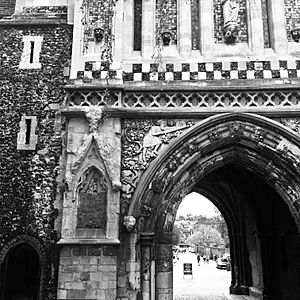
The Blessed Virgin Mary and Saint Ethelbert are the joint patrons of Hereford Cathedral. Music for the Office of St Ethelbert (a church service) from the 13th century still exists there.
St. Ethelbert's Gate is one of the two main entrances to Norwich Cathedral. A chapel near Ipswich was also dedicated to Æthelberht. In Wiltshire, the Church of England parish church at Luckington is dedicated to St Mary and St Ethelbert.
Many churches in Norfolk and Suffolk are also named after him. These include churches in Alby, East Wretham, Larling, Thurton, Mundham, and Burnham Sutton in Norfolk. In Suffolk, churches in Falkenham, Hessett, Herringswell, and Tannington are dedicated to him. In Essex, the church at Belchamp Otten is dedicated to St Ethelbert and All Saints. The church at Stanway is dedicated to St Albright, which is believed to be the same saint. In 1937, St Ethelbert's name was added to the parish church of St George in East Ham, London. This was because Hereford Cathedral helped pay for the church's rebuilding.
Images for kids


